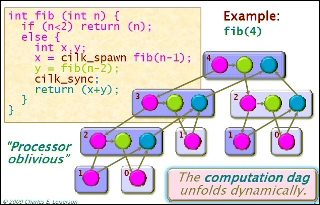Performance Engineering of Software Systems
As taught in: Fall 2009

Execution model for Fibonacci calculation. For more details, please see Lecture 12, Parallelism and Performance. (Image by Prof. Charles Leiserson.)
Instructors:
Prof. Charles Leiserson
Prof. Saman Amarasinghe
MIT Course Number:
6.172
Level:
Course Features
Course Description
Modern computing platforms provide unprecedented amounts of raw computational power. But significant complexity comes along with this power, to the point that making useful computations exploit even a fraction of the potential of the computing platform is a substantial challenge. Indeed, obtaining good performance requires a comprehensive understanding of all layers of the underlying platform, deep insight into the computation at hand, and the ingenuity and creativity required to obtain an effective mapping of the computation onto the machine. The reward for mastering these sophisticated and challenging topics is the ability to make computations that can process large amount of data orders of magnitude more quickly and efficiently and to obtain results that are unavailable with standard practice.
This course is a hands-on, project-based introduction to building scalable and high-performance software systems. Topics include: performance analysis, algorithmic techniques for high performance, instruction-level optimizations, cache and memory hierarchy optimization, parallel programming, and building scalable distributed systems.
The course also includes code reviews with industry mentors, as described in this MIT News article.


